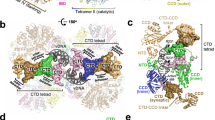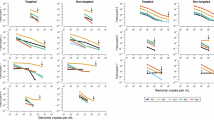Abstract
Manufacturing of retroviral vectors for gene therapy is complicated by the sensitivity of these viruses to stress forces during purification and concentration. To isolate viruses that are resistant to these manufacturing processes, we performed breeding of six ecotropic murine leukemia virus (MLV) strains by DNA shuffling. The envelope regions were shuffled to generate a recombinant library of 5 × 106 replication-competent retroviruses. This library was subjected to the concentration process three consecutive times, with amplification of the surviving viruses after each cycle. Several viral clones with greatly improved stabilities were isolated, with the best clone exhibiting no loss in titer under conditions that reduced the titers of the parental viruses by 30- to 100-fold. The envelopes of these resistant viruses differed in DNA and protein sequence, and all were complex chimeras derived from multiple parents. These studies demonstrate the utility of DNA shuffling in breeding viral strains with improved characteristics for gene therapy.
This is a preview of subscription content, access via your institution
Access options
Subscribe to this journal
Receive 12 print issues and online access
$259.00 per year
only $21.58 per issue
Buy this article
- Purchase on SpringerLink
- Instant access to full article PDF
Prices may be subject to local taxes which are calculated during checkout





Similar content being viewed by others
References
Braas, G., Searle, P.F., Slater, N.K.H. & Lyddiatt, A. Strategies for the isolation and purification of retroviral vectors for gene therapy. Bioseparation 6, 211– 228 (1996).
Friedmann, T. & Yee, J.-K. Pseudotyped retroviral vectors for studies of human gene therapy. Nat. Med. 6, 275–277 (1995).
Burns, J.C., Friedmann, T., Driever, W., Burrascano, M. & Yee, J.-K. Vesicular stomatitis virus G glycoprotein pseudotyped retroviral vectors: concentration to very high tier and efficient transfer into mammalian and nonmammalian cells. Proc. Natl. Acad. Sci. USA 90, 8033– 8037 (1993).
Green, N. et al. Sequence-specific antibodies show that maturation of Moloney leukemia virus envelope polyprotein involves removal of a COOH-terminal peptide. Proc. Natl. Acad. Sci. USA 78, 6023– 6027 (1981).
Hunter, E. & Swanstrom, R. Retrovirus envelope glycoproteins. Curr. Top. Microbiol. Immunol. 157, 187–253 (1990).
Fass, D. & Kim, P. S. Dissection of a retrovirus envelope protein reveals structural similarity to influenza hemagglutinin. Curr. Biol. 5, 1377–1383 (1995).
Fass, D.M., Harrison, S.C. & Kim, P.S. Retrovirus envelope domain at 1.7 Å resolution . Nat. Struct. Biol. 3, 465– 469 (1996).
Bae, Y., Kingsman, S.M. & Kingsman, A.J. Functional dissection of the Moloney Murine Leukemia Virus envelope protein gp70. J. Virol. 71, 2092–2099 (1997).
Aboud, M., Wolsson, M., Hassan, Y. & Huleihel, M. Rapid purification of extracellular and intracellular Moloney murine leukemia virus. Arch. Virol. 71, 185–195 (1982).
Pinter, A., Lieman-Hurwitz, J. & Fleissner, E. The nature of the association between the murine leukemia virus envelope proteins. Virology 91, 345 –351 (1978).
McGrath, M., Witte, O., Fincus, T. & Weissman, I.L. Retrovirus purification: method that conserves glycoprotein and maximizes yield. J. Virol. 25, 923–927 ( 1978).
Paul, R.W., Morris, D., Hess, B.W., Dunn, J. & Overell, R.W. Increased viral titer through concentration of viral harvests from retroviral packaging lines. Hum. Gene Ther. 4, 609–615 ( 1993).
Stemmer, W.P.C. Rapid evolution of a protein in vitro by DNA shuffling. Nature 370, 389–391 ( 1994).
Crameri, A., Raillard, S.-A., Bermudez, E. & Stemmer, W.P.C. DNA shuffling of a family of genes from diverse species accelerates directed evolution. Nature 391, 288– 291 (1998).
Soong, N.-W. et al. Molecular breeding of viruses. Nat. Genet. 25, 436–439 (2000).
Emi, N., Friedmann, T. & Yee, J.-K. Pseudotype formation of murine leukemia virus with the G protein of vesicular stomatitis virus. J. Virol. 6, 1202–1207 (1991).
Yee, J.-K., Friedmann, T. & Burns, J.C. Generation of high-titer pseudotyped retroviral vectors with very broad host range. Methods Cell Biol. 43, 99–112 (1994).
Gray, K.D. & Roth, M.J. Mutational analysis of the envelope gene of Moloney Murine Leukemia Virus. J. Virol. 67, 3489–3496 ( 1993).
Zavorotinskaya, T. & Albritton, L.M. A hydrophobic patch in ecotropic murine leukemia virus envelope protein is the putative binding site for a critical tyrosine residue on the cellular receptor. J. Virol. 73, 10164–10172 (1999).
Lyons, R.M. et al. An improved retroviral vector encoding the herpes simplex virus thymidine kinase gene increases antitumor efficacy in vivo. Cancer Gene Ther. 2, 273–280 ( 1995).
Acknowledgements
We thank S. Goff for the pNCA Moloney molecular clone.
Author information
Authors and Affiliations
Corresponding author
Supplementary information
Rights and permissions
About this article
Cite this article
Powell, S., Kaloss, M., Pinkstaff, A. et al. Breeding of retroviruses by DNA shuffling for improved stability and processing yields. Nat Biotechnol 18, 1279–1282 (2000). https://doi.org/10.1038/82391
Received:
Accepted:
Issue date:
DOI: https://doi.org/10.1038/82391
This article is cited by
-
Gene Therapy for the Nervous System: Challenges and New Strategies
Neurotherapeutics (2014)
-
Engineering a serum-resistant and thermostable vesicular stomatitis virus G glycoprotein for pseudotyping retroviral and lentiviral vectors
Gene Therapy (2013)
-
In vitro rapid evolution of fungal immunomodulatory proteins by DNA family shuffling
Applied Microbiology and Biotechnology (2013)
-
Engineering of a Stable Retroviral Gene Delivery Vector by Directed Evolution
Molecular Therapy (2008)
-
Revealing biases inherent in recombination protocols
BMC Biotechnology (2007)



